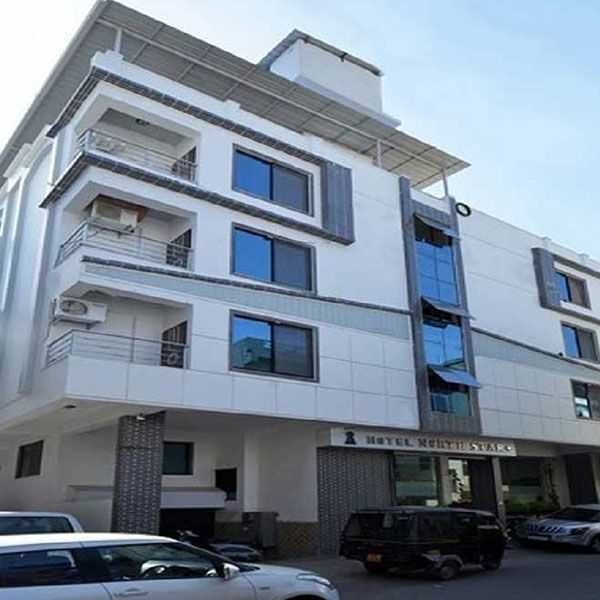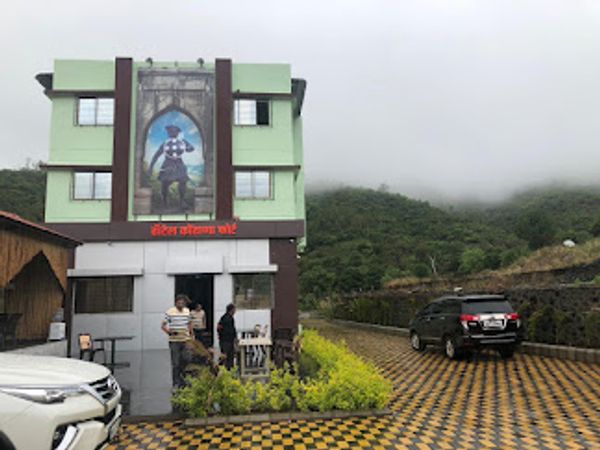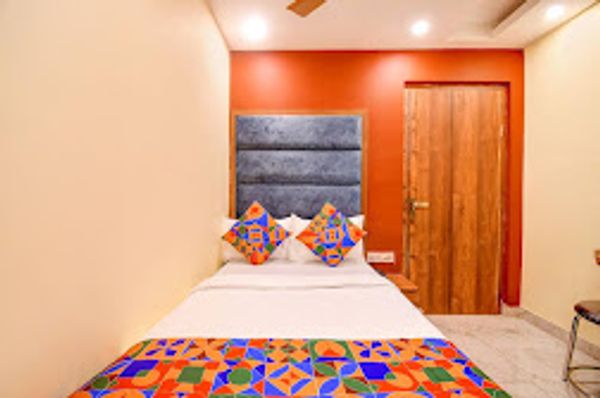Best Time to Visit Valley of Flowers Trek: Month-Wise Blooming, Weather & Temperature Guide
 Mountains Curve
16 Jul, 2025
33 mins read
121
Mountains Curve
16 Jul, 2025
33 mins read
121
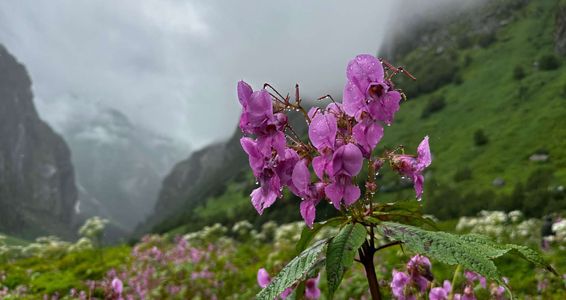
Determining the best time to visit Valley of Flowers can make the difference between a stunning wildflower spectacle and a misty, subdued landscape. This UNESCO World Heritage Site in Chamoli, Uttarakhand, India is famed for its richly colored alpine blooms and sweeping meadows. The valley explodes with color after the monsoon rains, whereas early summer brings only the first buds and late autumn heralds the onset of snow. The park generally opens in June and closes by mid-October
Each month offers a unique scene: June’s trails are quiet with the first green shoots peeking out; July through August is peak bloom under moody skies; September brings clearer weather and golden hues; and October sees fading flowers and incoming winter. For example, one guide notes that the Valley “opens every year from June to early October†and that mid-July to mid-August is when it is “in full bloomâ€. In short, each season has its own magic—from quiet, bud-covered meadows to cloud-shrouded, flower-filled vistas. Scroll down to learn which month matches your trekking style and interests.
Introduction to Valley of Flowers Trek
The Valley of Flowers Trek is a moderate 6-day Himalayan hike (including approach from Rishikesh) that gains almost ~10,498 ft in elevation. It begins at Govindghat (about 6,000 ft) and ascends gently to the village of Ghangaria (≈10,167 ft), the basecamp for the Valley and Hemkund Sahib.
From Ghangaria the trail to the Valley entrance is a short 4 km one-way trek (roughly 8 km round-trip) through stunning meadows. Those who wish to include Hemkund Sahib continue on a steep 6 km climb to the glacial lake and gurudwara at 14,203 ft. The route features expansive flower-filled meadows, flowing streams (the Pushpawati River runs through the valley), cascading waterfalls and panoramic views of snow-capped Himalayan peaks.
The park is home to hundreds of plant species; in fact, roughly 500–600 species of alpine flowers have been recorded here, including rare blooms like the Himalayan Brahma Kamal, Cobra Lily and Blue Poppy. All of this biodiversity is set within the Nanda Devi Biosphere – the valley was officially declared a UNESCO World Heritage Site in 2005 for its rich flora and fauna.
Despite its dramatic setting, the trek itself is considered moderate difficulty. Aside from the Hemkund segment (a strenuous ascent above 14,000 ft), most of the trail involves gradual climbs. A healthy beginner with some fitness can manage it. The typical itinerary covers about 40 km total (roundtrip) over 6 days. (By comparison, simply visiting the Valley of Flowers NP from Ghangaria is about a 4 km hike each way – roughly 5–7 hours – and can be done in a single day.)
Note that this trek is in the monsoon season, and preparation for rain and slippery paths is essential. Guides strongly recommend trekking from mid-July through mid-August if seeing the flowers is your main goal, as you’ll have a front-row seat to the valley’s floral show.
Best Time to Visit the Valley of Flowers
Overall, mid-July through mid-August is widely cited as the ideal period to experience the Valley in its full glory. By this time the summer monsoon has drenched the meadows, and wildflowers of every color burst into bloom. For example, one trek guide emphasizes that if seeing flowers is a priority, the “best time to visit Valley of Flowers is from the last week of July to August 15â€.
During these weeks, virtually all species are flowering: carpets of balsams, primulas, marigolds, wild roses and countless orchids cover the valley floor. Even rare giants like the Brahma Kamal and Cobra Lily appear along the trail.
The scenery is spectacular: misty skies often hover over lush green meadows, framed by fog-shrouded peaks and roaring waterfalls (fed by melted snow). As one account puts it, trekking through the Valley of Flowers in monsoon feels like climbing a stairway to heaven.
The weather in peak season is generally cool and wet. Daytime highs in late July–August average around 10–18 °C, dropping to near 3–5 °C at night. Light rain or drizzle is frequent (hence the need for a waterproof poncho or rain jacket), but at higher camps it often appears as mist or light drizzle rather than downpour. Even when rain does fall, the showers are usually manageable with good gear. In fact, trekkers note that the first half of July often has less rain – the real deluge comes by late July and August. These drizzles make the flowers grow, turn the forests emerald, and power the falls, though hikers should watch for muddy patches and occasional roadblocks from landslides on access routes.
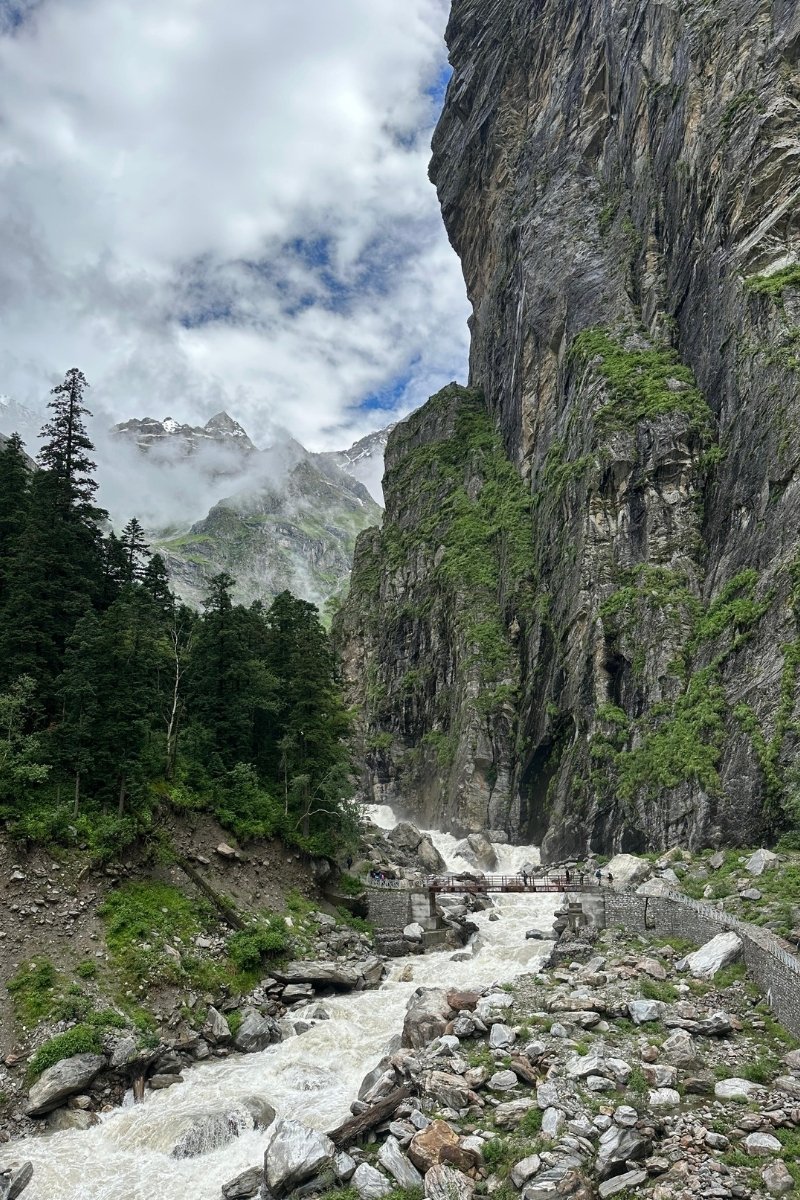
Crucially, the monsoon brings peak crowds. August is especially busy, so if you prefer fewer people on the trail, consider late July or mid-September instead. (On the upside, the Badrinath road beyond Govindghat is often empty in monsoon, so nearby pilgrimage sites are quieter.)
In summary, late July to early August delivers the densest blossoms and highest water volumes, making it perfect for flower lovers and photographers. The trail remains moderate in difficulty, but expect sloppy patches and plan for an extra day for poor weather. In any case, make sure to time your visit around the monsoon – outside of this window the valley simply isn’t as floral.
Valley of Flowers in June:
The trek opens in early June, but this is essentially the pre-bloom season. The valley is still shaking off winter: many snow patches linger and only the first flower buds begin to show.
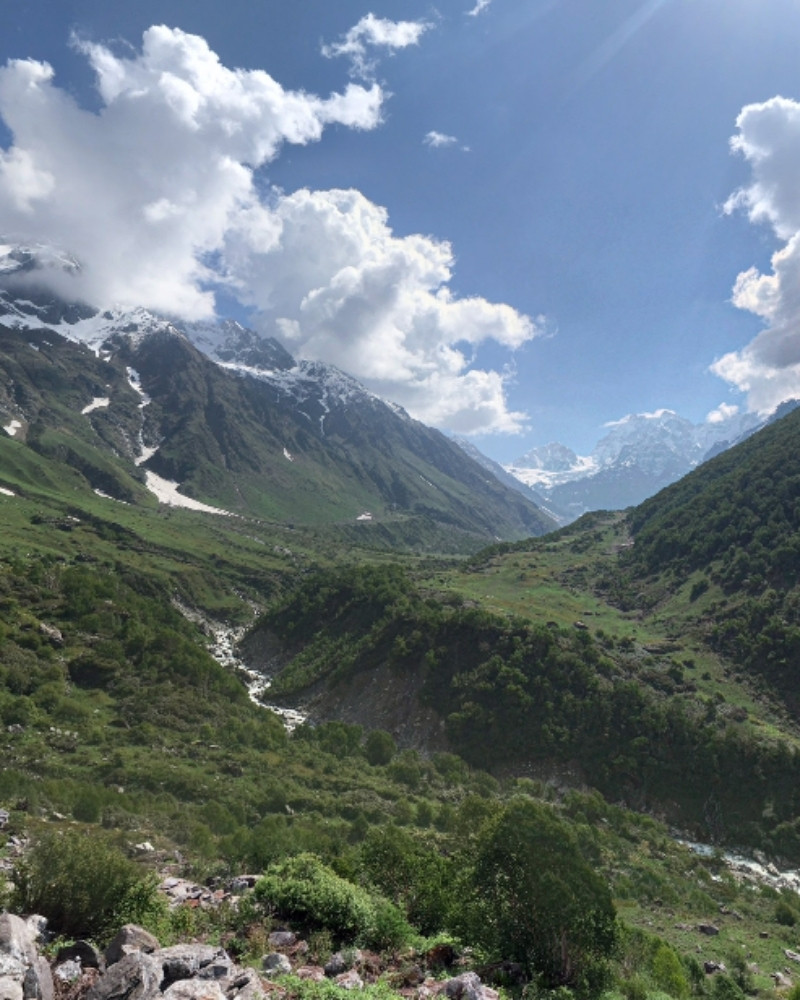
Hikers in June see “many tiny buds and sprouts ready to transform into vibrant bloomsâ€, but not the riot of colors yet. For example, you might spot wild thyme, Himalayan strawberries, marsh marigolds and smooth violets just poking through the grass. The meadows start to turn green, and the Himalayan peaks are still capped with snow.
The weather is dry (trails are mostly snow-free and rain is very rare) and daytime temperatures at lower altitudes can be warm (around 17–29 °C), though nights are still cold.
Overall, June treks are quiet: very few tourists venture here this early, so the trails are nearly empty. It’s best for nature lovers who appreciate early-season solitude. However, many guides note that early June is typically not recommended because parts of the trail may still be blocked by lingering snow.
In short, June offers an opening glimpse at the valley (clear skies and fresh greenery), but few full blooms.
- Crowd Level: Very low – you may trek for hours without meeting other hikers. Govindghat is quiet and there is a relaxed, off-peak atmosphere. This makes June ideal for solitude seekers.
- Weather & Temperature: June days are mild; one source records daytime highs up to 29 °C and lows around 2 °C. Monsoon rains have not yet arrived (it “rains virtually no days†in June), so trails are clear. Nights are cold at altitude, so bring warm clothes.
Valley of Flowers in July:
July brings the onset of monsoon to the higher Himalayas, and the valley quickly comes to life. In the first half of July the valley is already lush with greenery. Flowering accelerates by mid-month – as one guide notes, “flowers start to bloom in abundance from mid-July onwards. The valley turns extremely colourfulâ€. You’ll see carpets of primulas, asters, balsams and poppies covering the meadows, interspersed with snow-drifts in the glades. Even the famous Brahma Kamal and Cobra Lily may start to appear in July.
The first snows of the season melt and waterfalls swell. Days remain cool (about 6–11 °C at the valley floor), and early morning clouds often lift to reveal spectacular vistas. July is also a good compromise in terms of crowds and weather. In fact, July is often less crowded than August, especially in the early weeks. The first half of July sees relatively light rain (“a very pleasant experience†for trekking), so you can enjoy many sunny spells.
Later in the month, showers become more frequent, so be prepared with rain gear. Even with rains, daytime hiking is still pleasant. Note that heavy monsoon downpours can sometimes block roads on the approach (the Lambagad landslide zone can cause closures), so stay flexible.
In summary, July gives you peak lushness with somewhat fewer crowds: the valley is green and increasingly flower-filled. For many trekkers this is an excellent time to experience the blooms.
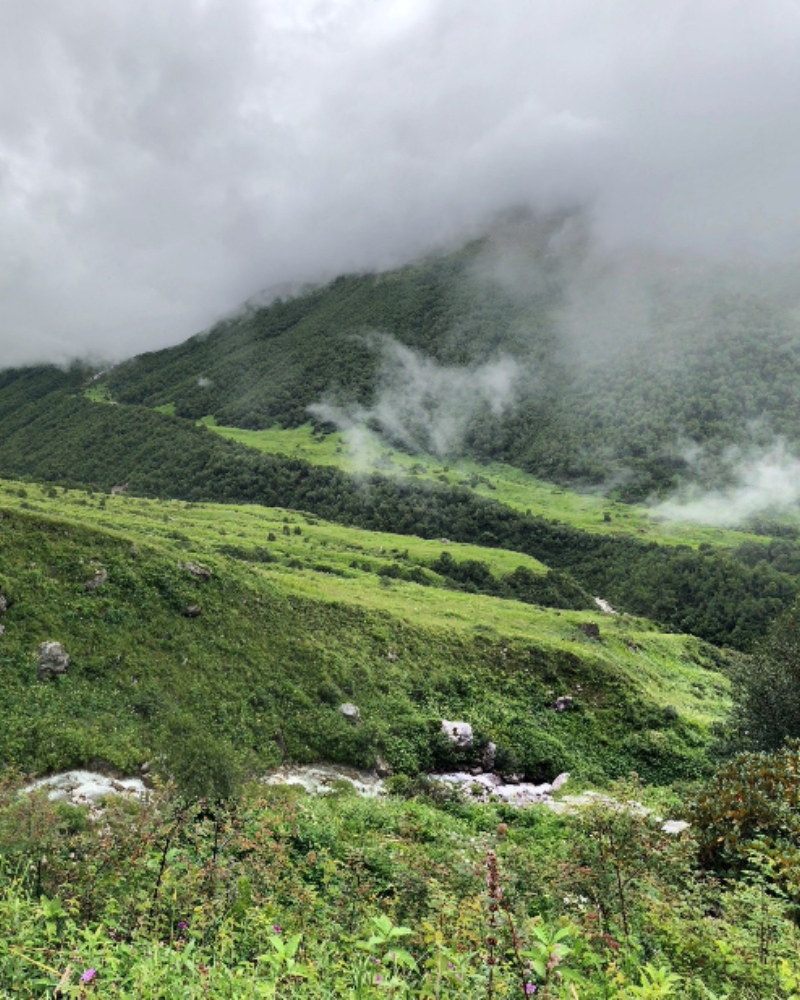
- Crowd Level: Lower than in August. July tends to be “least crowded†of the popular months. Many trekkers arrive in August, so July offers relatively quiet trails – an advantage if you prefer space.
- Weather & Temperature: Cool and wet. Daytime highs hover around 6–11 °C at valley level. The first half of July is fairly dry, but expect rain showers (occasionally heavy) by late July. The weather is generally manageable for hiking, provided you carry waterproof gear and warm layers for nighttime.
Valley of Flowers in August
August is often cited as the absolute peak blooming season – “the most number of flowers†appear in early August. Virtually every flower species in the valley is at or near full bloom in the first two weeks of August. Meantime, the monsoon is in full swing: rain and mist are daily companions. Heavy showers can drench the trails, but they also make the valley truly spectacular. As one ranger notes, August brings “a number of flowers†and is considered the best time to see the valley in its glory. While some petals may get battered by wind and rain, the payoff is a breathtaking panorama of color under swirling clouds. Because of the rain, proper gear is essential in August.
Expect daytime temperatures around 6–12 °C, with frequent downpours (sometimes heavy) and often foggy or overcast skies. The valley is lush and white mist often drifts through the flowers, creating a moody, beautiful scene. Trekking can be “slippery†and the rocks are wet, so good boots and trekking poles are advised.
Still, the park remains accessible: trails are usually open (albeit muddy) up through early September. Many hikers find the effort worthwhile. If you can handle the rain, this is truly one of the best times to visit, as nearly all the alpine flowers – from blue Himalayan poppies to red balsams to the Brahma Kamal – are out. (Be aware that the Badrinath road may be prone to landslides in heavy monsoon; check conditions.)
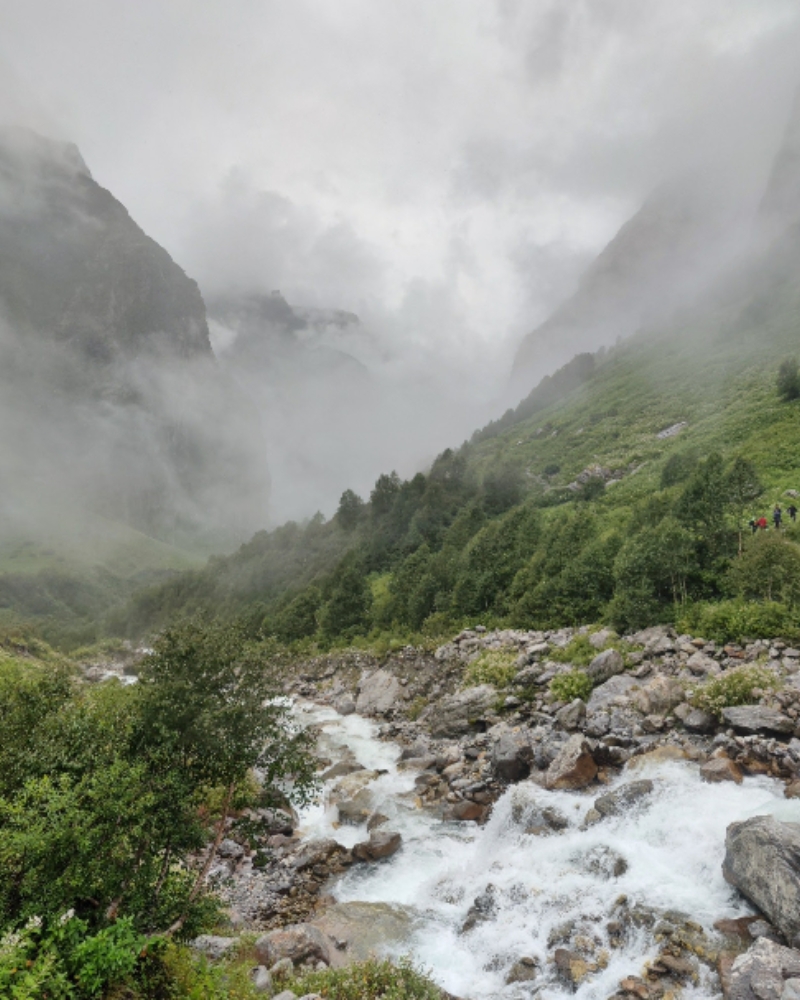
- Crowd Level: Very high. This is peak season for flower-trekkers. Trails (especially on weekends) can be busy. If possible, trek midweek to avoid the worst of the crowds. Note that Badrinath temple stays nearly empty during August rains, if you plan to visit.
- Weather & Temperature: Cold and wet. Expect heavy rain on many days. The temperature at Ghangaria/Valley stays around 6–12 °C, so pack warm layers and waterproofs. Cloud cover limits sunlight, so it may feel chilly. However, storms often clear in the morning or evening, giving striking light on the meadows.
Valley of Flowers in September
By September the monsoon is waning and the scenery changes again. The rains drop off rapidly (“monsoons retreating by mid-Septemberâ€), revealing clearer blue skies and crisper views of the peaks. The valley’s green meadows begin to yellow as autumn approaches. Many flowers have already matured and wilted, so you’ll see fewer blooms, replaced in part by berries and seed pods. For instance, expert guides note that by September the “flowers have wilted away and there are very few leftâ€. However, there are still blooms to be found in sheltered spots (especially around Hemkund) if you look carefully.
September can actually be quite pleasant for trekking. The weather is drier and more predictable: trails become grippier and the air is clean, with daytime temperatures around 10–18 °C. Clouds often break, giving spectacular mountain panoramas.
Crowds thin out compared to August – but note the caveat that pilgrim groups to Hemkund surge in September. In fact, the Valley itself may feel more crowded because of Sikhs on their Hemkund pilgrimage. If solitude is your goal, mid-September (weekday) is better than early September (weekends).
In short, September offers a quieter, drier trek with beautiful yellow-green scenery and some late-season blooms. It is past the floral peak, but can be rewarding for those who don’t mind missing most of the flower show.
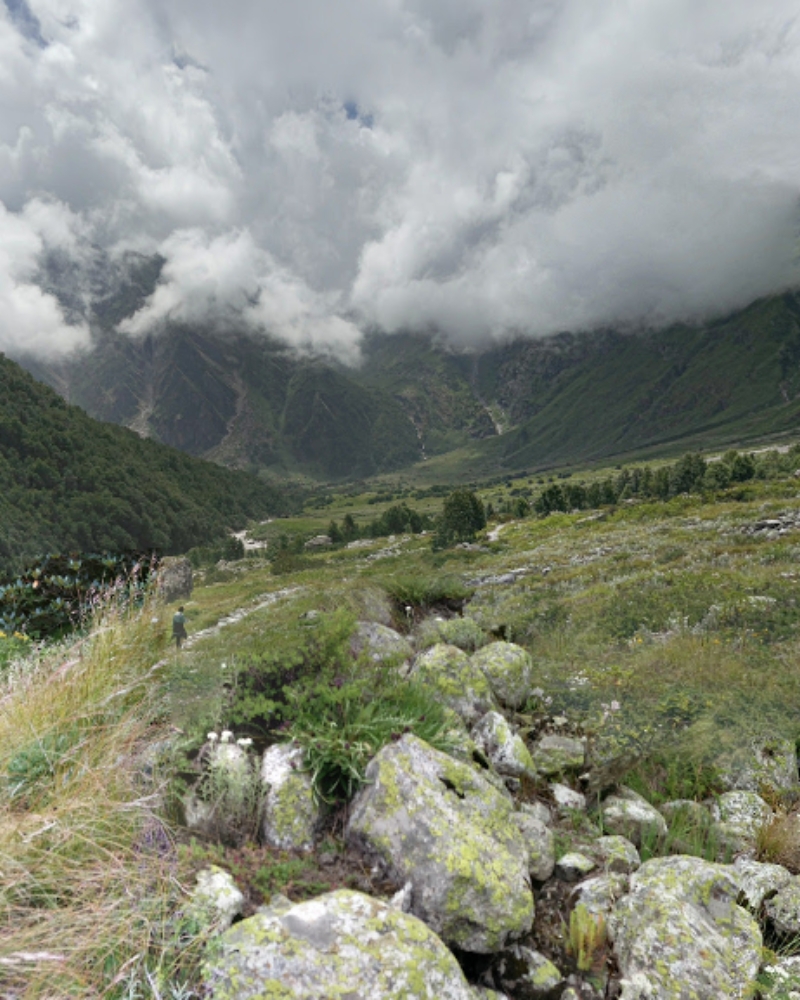
- Flowers Condition: Diminished. Most wildflowers have already bloomed and faded by mid-September. You’ll see more autumn berries and seed clusters than carpets of flowers, though patches of white primulas or blooms on the hill slopes may still linger. The valley gradually shifts from emerald to yellow-gold.
- Crowd Level: Moderate. General tourist traffic is much lighter, but weekends can see large groups heading to Hemkund Sahib. A trek on a weekday will feel relatively peaceful.
- Weather & Temperature: Dry and clear. The monsoon is essentially over (“almost die down by mid-Septemberâ€), so days are sunny and the nights crisp. Daytime highs remain around 10–18 °C, making for comfortable hiking. The lack of rain means trails are stable and panoramic views are excellent.
Valley of Flowers in October
By October the valley is past its prime and preparing for winter. Many guides note that flowers are mostly gone by mid-October and the valley closes around then. The greenery gives way to autumn tones and soon to snow. For example, a travel site explains that the valley is typically “closed for touring†by the third week of October as winter arrives.
In early October you might still see some late dahlias or wild asters at lower spots, but the main bloom is over. If you trek in early October, the major attractions are the golden meadows and mountain views, not flowers.
Daytime weather can be fine (max around 15–17 °C) but nights fall well below freezing. Snow often returns by late October. Crowds are minimal, but so are blooming plants. This is essentially the off-season – park offices close and only very determined trekkers head up.
In summary, October offers clear air and autumn scenery but no more floral shows, and heavy winter gear is soon required.
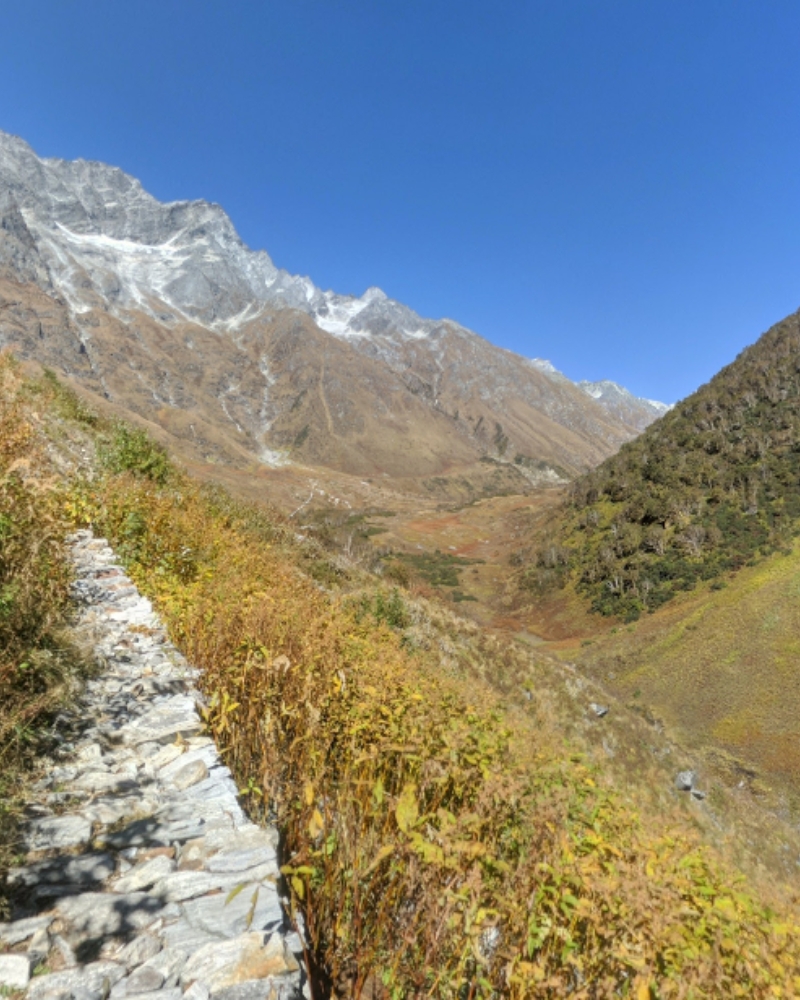
- Flowers Condition: All but finished. Only sparse remnants of the last blooms remain; most trails are foliage and bare earth. Any flowers present will be a few early chrysanthemums or hardy asters.
- Crowd Level: Very low. The valley sees almost no tourist activity by this time – few trekkers venture out in the cold.
- Weather & Temperature: Cold. The weather can still be pleasant by day (max ~15–17 °C), but nights are freezing (often below 0 °C). Heavy jackets and warm hats are essential if you go. Snowfall and frosts become likely, especially after mid-October.
Summary of Best Months for the Valley of Flowers Trek
In summary, the best month depends on what you want to see. If maximum flowers and waterfalls are your priority, aim for late July through early August. This is when the valley is most lush and colorful, with rain-fed streams full and rare blooms everywhere.
Early July can also be excellent (the flowers start emerging, and the valley is deep green with relatively fewer trekkers). By contrast, September trades off a good number of flowers for steadier weather and clearer views. June offers only early buds (good for solitude), and October brings autumn colors but virtually no blooms.
For many trekkers, mid-July to mid-August is ideal – even though it’s monsoon season, it delivers the valley at its floral peak. Others who dislike heavy rain might favor the edges of that window: early July or very late August/early September.
In any case, each month has its charm. As one expert puts it, the valley is “at its best, in full bloom†in this season. Ultimately, weigh your priorities (flowers vs. weather vs. crowd) and plan accordingly – the valley of flowers in monsoon is the time that meets your trekking goals.
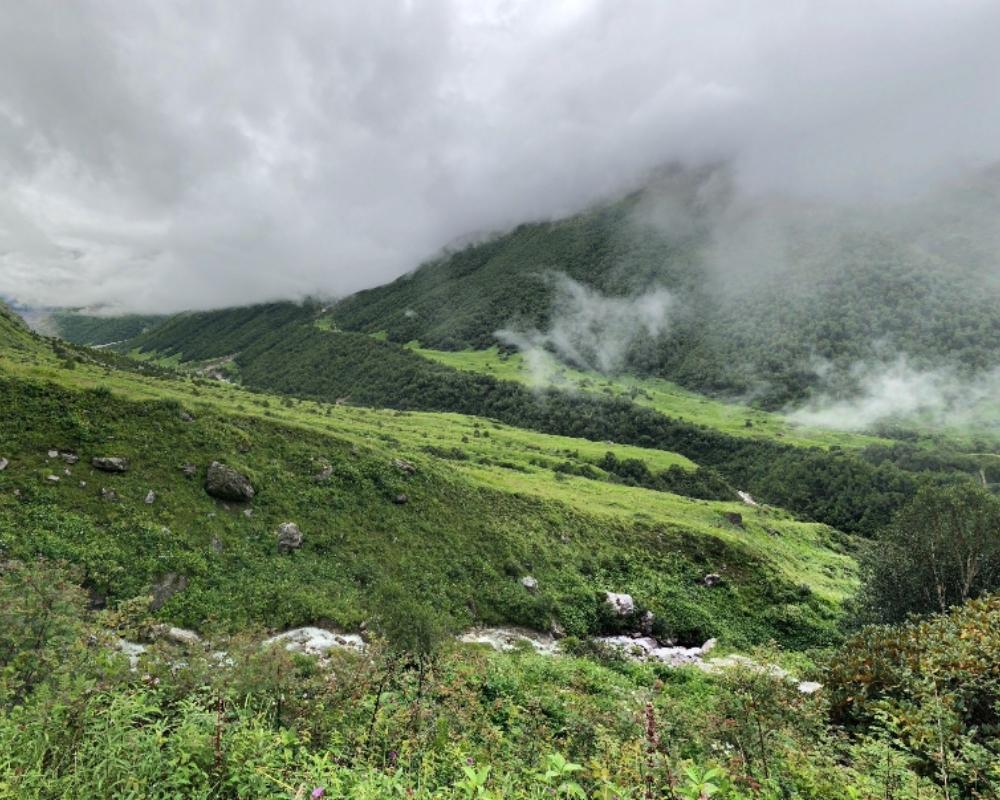
Tips for Monsoon Trek to Valley of Flowers
Carry Quality Rain Gear: The trail is a monsoon trek. Pack a good waterproof raincoat or poncho and rain covers for your backpack.
Wear Sturdy Waterproof Boots: Hilly paths can get very muddy and slippery. Strong, waterproof trekking shoes with good grip are essential.
Dress in Layers: Daytime can still be cool, so bring thermal base layers, a fleece or wool sweater, and a windproof jacket. Don’t forget a woolen cap and gloves for the chilly evenings.
Bring Permits and Identification: You’ll need entry permits at Ghangaria and forest checkposts, so carry a government ID and keep copies safe.
Pack Snacks and Hydration: Keep energy up with dry snacks (energy bars, nuts, dry fruit) and carry enough water or a hydration pack. Drink only purified/boiled water.
Start Early: Afternoon thunderstorms are common in monsoon. Begin hikes at dawn so you can be off the trail by noon or early afternoon. This also avoids peak sun later in the day.
Acclimatize and Know Altitude: Spend a night at Govindghat or Ghangaria before pushing higher, to adjust. Carry basic altitude sickness medication if needed.
Bring Sun Protection: Even on overcast days UV rays are strong at altitude. Pack sunscreen, sunglasses and a sunhat.
Use Trekking Poles: A sturdy walking stick or trekking poles help on uneven, slippery paths and reduce strain on knees.
Respect the Environment: Leave no trace. Don’t pick flowers or litter. Carry out all trash. The Valley of Flowers is a protected area – please keep it clean for others.
Essential Things To Carry for the Trek
- Raincoat/Poncho: A high-quality waterproof rain jacket or poncho is non-negotiable. Even if the sun is shining when you start, afternoon showers can drench you. A poncho is handy because it covers both you and your pack.
- Waterproof Trousers: Lightweight waterproof pants will keep your legs dry when hiking through wet grass or streams. They help prevent hypothermia and chafing on muddy trails.
- Trekking Boots: Bring sturdy hiking boots that are well broken-in. They should be waterproof with good ankle support. Wet, rocky trails can be treacherous in soggy conditions, so reliable boots are critical for safety and comfort.
- Warm Layers: Include warm layers (thermal underwear, fleece or wool sweaters). Even in summer, early mornings and nights can be cold (often near or below freezing at camp). A warm jacket (fleece or down) is vital for camp and summit pushes.
- Gloves and Woolen Hat: Cold winds can bite, especially at higher altitudes like Hemkund. A pair of warm gloves (or glove liners) and a woolen cap will keep extremities warm during rest breaks or if the weather turns cold quickly.
- Backpack with Rain Cover: Use a daypack (30–40 L) with padded straps and rain cover. A rain cover (or liner bag) protects your gear from getting soaked. Pack light and keep essential items (camera, electronics, first-aid) in waterproof bags or zip-locks inside.
- Water Bottle / Hydration System: Carry at least 2–3 liters of water capacity. Staying hydrated is crucial at altitude. You can refill at streams (use purification tablets or boil), but always start the day with a full supply and drink regularly as you hike.
- Headlamp / Flashlight: A headlamp is useful for early morning starts (e.g. Hemkund trek) or if you stay up after dark. It also helps in case of delays on the trail. Bring extra batteries, as monsoon clouds mean very early sunsets.
- First Aid Kit: A compact first-aid kit (with blister pads, bandages, painkillers, any personal meds, and altitude sickness medicine) is essential. Carrying some basic antibiotics and stomach remedies is wise on a long trek.
- Sun Protection: Even in mist, UV rays at high altitude can burn. Pack sunscreen (SPF 30+), lip balm, and UV-blocking sunglasses. These protect against sunburn and snow/glacier glare, especially if the sky clears after rain.
- Snacks / Energy Foods: High-calorie snacks (energy bars, dry fruits, nuts, chocolate) help maintain energy on steep sections. Pack enough snacks for each day, as mountain food can be limited.
Conclusion about the Best Time for Valley of Flowers Trek
The Valley of Flowers is an ultimate Himalayan beauty, with its spiritual significance and timing your visit well will make it unforgettable. In short, the Valley of Flowers's best time generally falls in the high monsoon (mid-July to mid-August), when wildflowers are most abundant and the landscapes are lush. June offers the quiet thrill of first blooms in the background of Garhwal Himalayas, and September provides clearer weather and golden meadows. Regardless of when you go, be prepared for sudden weather changes and pack accordingly. Carry rain gear and warm clothes, follow trail safety, and respect the fragile ecosystem. With the right timing and preparation, you’ll experience this UNESCO park at its finest – from sunlit flower-carpeted valleys to misty waterfalls. Ultimately, “if you really want to see lots of flowers, time your trek from the last week of July to the middle of Augustâ€. But whatever month you choose, the Valley’s beauty will surely reward the effort.
Written By:
Mountains Curve



Hotels at your convenience
Now choose your stay according to your preference. From finding a place for your dream destination or a mere weekend getaway to business accommodations or brief stay, we have got you covered. Explore hotels as per your mood.
